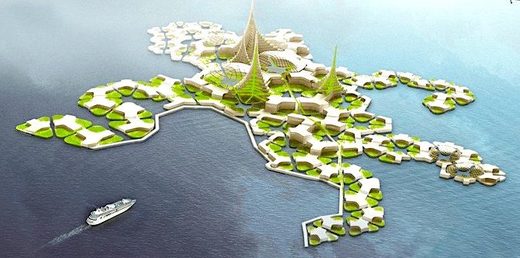
But this past January 13, the dream came one step closer to reality when the Seastead Institute signed a deal with French Polynesia that lays the legal groundwork for the world's first semi-autonomous floating city-state.
French Polynesia is a cluster of more than 100 islands in the South Pacific, the biggest and best-known being Tahiti. Like other coastal and island nations in the Pacific, French Polynesia is courting investment in the so-called "blue economy," the sustainable development of offshore energy production, wild-catch fisheries, aquaculture and tourism. The Polynesians are less interested in the seasteaders libertarian politics than their promise of delivering a high-tech floating village that will not only provide jobs for Polynesian workers, but attract investment dollars for Polynesian entrepreneurs.
Joe Quirk is the Seasteading Institute's staff "Seavangelist" and author of the forthcoming Seasteading: How Ocean Cities Will Change the World, written with Seasteading Institute co-founder Patri Friedman. Quirk was part of a 10-person team who visited French Polynesia back in September. "This was a Polynesian-initiated project," Quirk told Seeker. "They reached out to us. It's an ideal country for seasteading, and they think we're the perfect industry for what they want to do with regard to the blue economy."
The long-term vision of seasteading is to construct fully autonomous floating cities on the high seas where the "next generation of pioneers [can] peacefully test new ideas for government." But for this first, proof-of-concept project, the Seasteading Institute was searching for an island partner with protected shallow waters and an openness to new type of economic model called a SeaZone.
For the past 40 years, countries across Asia and Latin America have established special economic zones (SEZs) with low corporate taxes and light regulation to lure foreign investment. The most famous SEZ is the Chinese city of Shenzhen, a sleepy fishing village which became China's first SEZ in 1980. Today it's a manufacturing and export hub of 10 million residents generating $230 billion in GDP.
SeaZones, as envisioned by the Seasteading Institute, do more than simply extend the SEZ concept offshore. Over the next year, the Seasteading Institute will be negotiating the legal terms of the SeaZone with the government of French Polynesia, which may include not only economic incentives, but a certain measure of political autonomy.
"Certainly the more [autonomy], the better," said Quirk, "But even if we just get something very modest, it could set a great example for what's possible. The exciting thing about French Polynesia is that it's as large as Western Europe, but only 1/1000th of it is land. They have lots of space to experiment with SeaZones."
The deal signed last week was just a memorandum of understanding between the Polynesian government and the Seasteading Institute. Before construction can begin on the pentagonal concrete platforms that would support the floating city, the Seasteading Institute and its Dutch engineering partner Blue21 must conduct economic and environmental impact studies.
Quirk said that the novel floating platforms are not only environmentally friendly, but environmentally restorative. Rising water temperatures in the South Pacific have killed much of French Polynesia's coral reefs. "Through the presence of small floating communities," said Quirk, "you could slightly lower the temperature of water in the immediate vicinity to spark the recovery of the corals."
Seasteading advocates envision a future where clusters of offshore communities serve as "green" foils to polluting coastal cities. The excess CO2 pumped out by cities can be captured by sprawling offshore algae farms and converted into biofuels. Nutrients leached away by wastewater can be used to fertilize floating vegetable farms and fisheries.
For now, though, it's all about building that first prototype and recruiting the first faithful seasteaders. If all goes smoothly with the Polynesian negotiations, Quirk said that construction could start as early as 2018 and the first units could be sold starting in 2019.
According to conceptual designs, the artificial islands will consist of interconnected pentagonal platforms measuring 50 meters on each side. Each platform will be a mix of commercial, residential and green space. Real estate on the first islands won't come cheap. At an estimated $504 per square foot, it's similar to housing prices in Manhattan and London.
Despite the cost, Quirk says that more than 3,000 people have already completed a detailed online survey expressing interest in being the floating city's first residents. "I don't think we're going to have any trouble finding people who want to live and open businesses on the first few islands," he said.
Billionaire Thiel is not currently involved in the Seasteading Institute or this first floating cities project in French Polynesia. When it became clear that libertarian islands on the open ocean would cost billions to build and secure, Thiel's initial passion for seasteading cooled.
But Quirk said the Seasteading Institute hasn't lost sight of its ultimate goal. "The Seasteading Institute is interested in taking incremental steps toward more autonomy so people can experiment with new societies," said Quirk. "The technological innovation and legal innovation are advancing in parallel toward a long-term view of moving out to the high seas."




So tell me, libertarians, why are taxes bad? Or are y'all just trying to get much richer under the guise of "innovation" like the industrial revolution robber barons did?